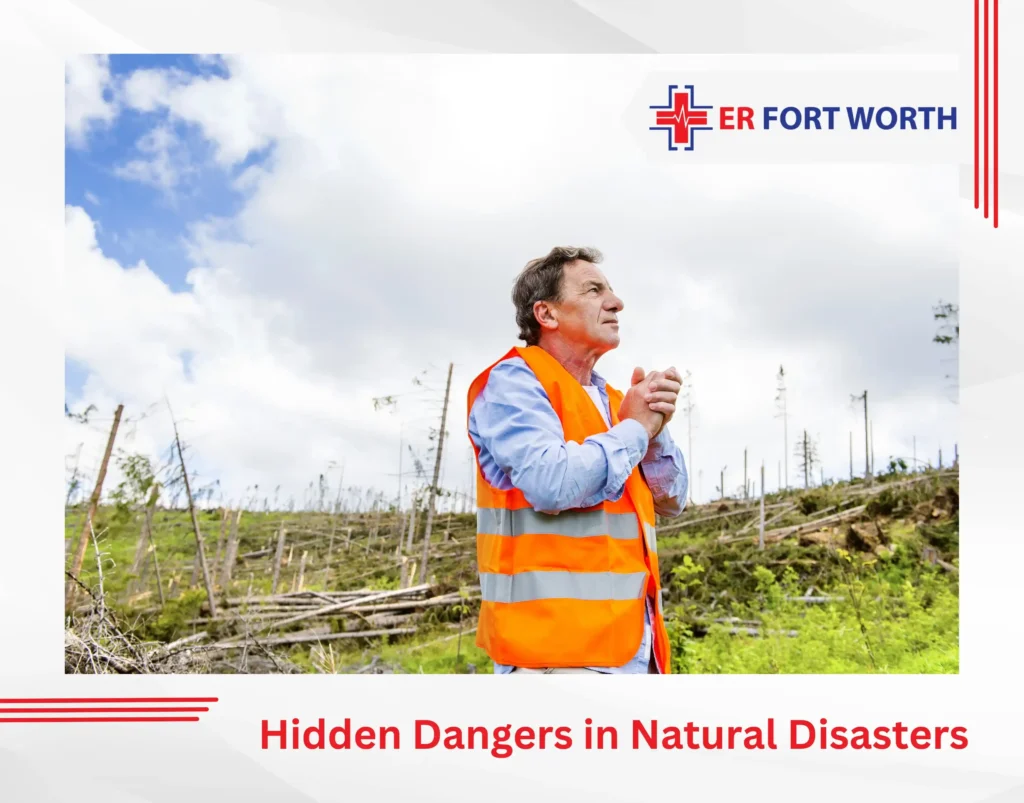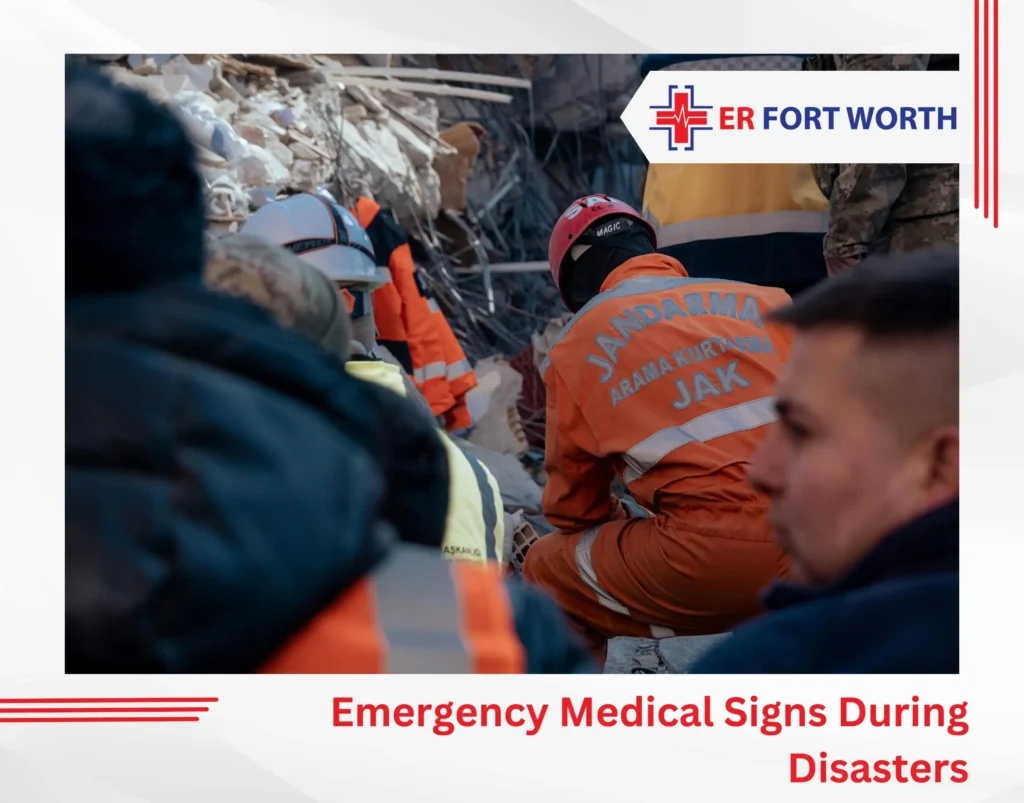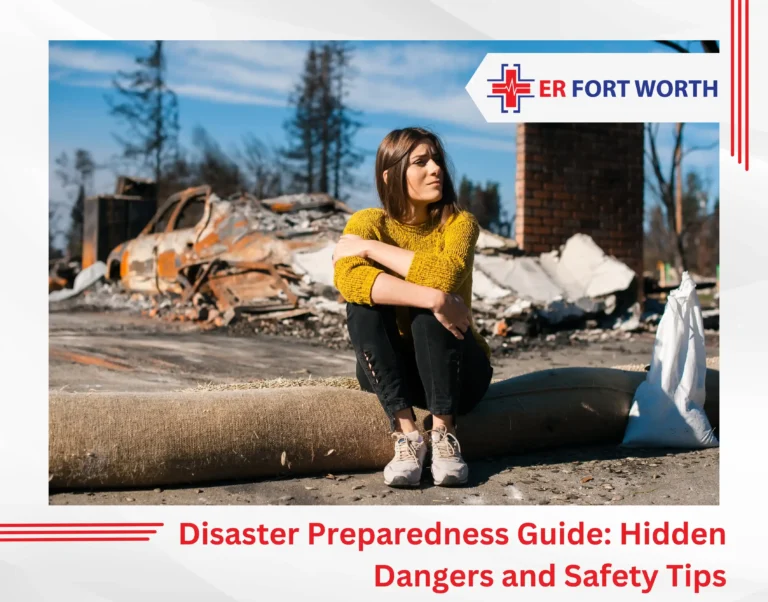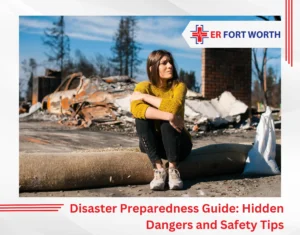Disaster preparedness goes beyond stockpiling water and batteries. The deadliest threats during disasters remain invisible to most people. Submerged power lines electrify floodwater, while damaged chemical storage releases toxic gases.
Floods kill through sewage contamination carrying hepatitis A and E. coli rather than drowning alone. Hurricanes create carbon monoxide poisoning when people run portable generators indoors. Wildfires leave soil contaminated with heavy metals and carcinogens that remain dangerous for months after flames pass.
This guide covers the specific hidden dangers in major disasters, emergency symptoms requiring immediate medical care, and essential supplies most preparedness guides overlook completely.
Hidden Dangers in Natural Disasters

Natural disasters create concealed threats that kill more people than the primary disaster itself. These hidden dangers emerge during and after the main event, catching survivors off guard when they believe the worst has passed.
1. Flood Disasters
Floodwater contains deadly threats that remain invisible beneath the surface. A few inches of moving water can knock an adult down, while two feet can sweep away vehicles. The real danger lies in what you cannot see.
I. Electrified Water from Submerged Power Lines
Downed electrical wires turn entire flood zones into death traps. Electricity can travel far through impure water, making it extremely dangerous to walk or drive through areas with standing or moving floodwater. You cannot detect electrical current by sight.
II. Raw Sewage and Industrial Chemical Contamination
Floodwater mixes with overflowing sewage systems and industrial runoff. This toxic combination carries hepatitis A, E. coli, and chemical burns that can enter through minor cuts.
III. Displaced Venomous Wildlife
Snakes, alligators, and fire ant colonies seek higher ground in flood zones. Stressed animals become aggressive and unpredictable. Fire ants form floating rafts that attack when disturbed.
IV. Hidden Ground Collapse and Sinkholes
Water erosion undermines roads, sidewalks, and building foundations. What appears to be shallow standing water may conceal deep sinkholes or collapsed pavement.
V. Sharp Debris Floating Below Surface
Broken glass, metal fragments, and construction materials float just beneath murky water. These objects can slash skin, puncture feet, or damage vehicle tires without warning.
VI. Fuel and Chemical Spills
Gasoline, oil, and industrial chemicals leak from submerged vehicles and storage tanks. These substances create fire hazards and cause severe skin burns or respiratory damage.
VII. Post-Flood Mold and Airborne Toxins
Toxic mold grows within 24-48 hours in water-damaged buildings. Mold spores trigger severe respiratory problems and can be fatal for people with a history of asthma or allergies.
2. Hurricane and Storm Disasters
Hurricanes create deadly threats that persist long after winds subside. Most hurricane fatalities occur during cleanup and recovery phases, not during the storm itself.
I. Carbon Monoxide from Emergency Generators
Portable generators kill more people than hurricane winds. Carbon monoxide accumulates rapidly in garages, basements, and near building ventilation systems. This colorless, odorless gas causes death within minutes.
II. Chainsaw and Cleanup Injuries
Inexperienced homeowners using chainsaws to clear debris cause severe lacerations and amputations. Wet wood, unstable trees, and electrical hazards multiply injury risks during cleanup operations.
III. Contaminated Well Water
Storm surge and flooding contaminate private wells with saltwater, sewage, and chemicals. Well water remains unsafe for weeks after storms pass, even when it appears clear and tastes normal.
IV. Structural Collapse from Wind Damage
Buildings weakened by hurricane winds collapse suddenly during recovery efforts. Damaged roof supports, compromised foundations, and loosened building materials fall without warning.
V. Infectious Disease from Standing Water
Stagnant water breeds disease-carrying mosquitoes within days. West Nile virus, Zika, and other mosquito-borne illnesses spike dramatically in hurricane aftermath areas.
3. Wildfire Emergencies
Wildfires leave behind contaminated landscapes that remain dangerous for months after flames extinguish. Toxic ash and compromised structures create ongoing health hazards.
I. Toxic Ash and Heavy Metal Contamination
Wildfire ash contains lead, arsenic, and other heavy metals from burned buildings. These toxins contaminate soil and water supplies, causing cancer and neurological damage with prolonged exposure.
II. Compromised Building Structures
Fire-damaged buildings collapse suddenly due to weakened steel supports and foundation damage. Structures may appear intact while remaining critically unstable.
III. Contaminated Water Systems
Plastic pipes melted by fire release toxic chemicals into water supplies. Benzene and other carcinogens contaminate drinking water for weeks after fire suppression efforts end.
IV. Respiratory Hazards from Lingering Smoke
Wildfire smoke contains fine particulates that penetrate deep into lungs. These particles trigger heart attacks, strokes, and severe asthma attacks in vulnerable populations.
V. Unstable Burned Trees and Terrain
Fire-damaged trees fall suddenly without warning. Burned slopes become unstable, causing mudslides and rockfalls during rain or wind events.
4. Earthquake Hazards

Earthquakes create hidden structural damage that causes delayed building collapses. Secondary hazards often prove more deadly than the initial ground shaking.
I. Gas Leaks and Fire Hazards
Ruptured gas lines create explosion risks that persist for days after earthquakes. Natural gas accumulates in buildings and underground spaces, igniting from any spark source.
II. Compromised Building Integrity
Earthquake damage weakens building structures invisibly. Load-bearing walls and foundations develop critical fractures that cause sudden collapse during aftershocks.
III. Liquefaction and Ground Instability
Saturated soil turns liquid during earthquakes, causing buildings to sink or tip over. This ground liquefaction continues affecting structures long after shaking stops.
IV. Broken Water and Sewer Systems
Earthquake damage contaminates drinking water with sewage and chemicals. Cross-contamination between water and sewer lines spreads waterborne diseases rapidly.
V. Hazardous Material Spills
Industrial facilities and laboratories release toxic chemicals during earthquake damage. These spills contaminate air, soil, and water without immediate detection or warning systems.
Disaster Preparedness Kit and Essential Actions
Your disaster preparedness kit and emergency knowledge work together to ensure survival during disasters. Most disaster preparedness fails because people focus on supplies while ignoring critical systems and actions that make those supplies useful.
1. Know Your Utility Shutoffs
Learn the exact location of your main water, gas, and electrical shutoffs before disaster strikes. Practice turning them off with the proper tools. Gas leaks kill more people during earthquakes than building collapses, yet most homeowners cannot locate their gas meter shutoff valve. Keep a wrench specifically for gas shutoffs in your emergency kit.
2. Document Everything Before Disaster
Photograph or video every room, important documents, and valuable items. Store copies in cloud storage accessible from any device. Insurance claims fail when people cannot prove ownership or document pre-disaster conditions. Include waterproof storage bags for important documents in your disaster preparedness kit.
3. Establish Communication Beyond Cell Towers
Cell towers fail during major disasters. Designate an out-of-state contact person for family members to check in with. Local calls may fail while long-distance calls go through. Program this contact into every family member’s phone. Pack a battery-powered or hand-crank radio and fully charged power banks as communication backups.
4. Cash Reserves for Infrastructure Failure
ATMs and credit card systems stop working when power grids fail. Keep at least $500 in small bills accessible at home. Banks and payment systems can remain offline for weeks after major disasters. Store cash in waterproof containers within your emergency supplies.
5. Medication Backup Plans
Obtain supplies of essential medications before high-risk disaster season. Know which pharmacies in surrounding areas carry your prescriptions. Dialysis patients and insulin-dependent diabetics suffer when medical supply chains break. Include basic first aid supplies, pain relievers, and antiseptics in your kit alongside prescription medications.
6. Transportation Alternatives
Keep vehicle gas tanks above half-full during high-risk periods. Identify multiple evacuation routes from your neighborhood. Gas stations lose power and run out of fuel within hours of disaster warnings. Pack emergency car supplies including jumper cables, tire repair kit, and emergency flares.
7. Essential Tools Most People Lack
Manual can opener, battery-powered radio, duct tape, plastic sheeting, and work gloves solve immediate post-disaster problems that prevent access to other supplies. Add a multi-tool, LED flashlights with extra batteries, and waterproof matches to handle basic repair and safety needs.
8. Water Purification Beyond Storage
Water storage runs out. Include water purification tablets and portable filters, and learn to purify questionable water using boiling, bleach, or filtration methods. Pack empty containers for collecting rainwater safely.
9. Food That Requires No Cooking
Canned goods become useless without working can openers or cooking methods. Stock ready-to-eat foods that provide complete nutrition: peanut butter, crackers, dried fruits, nuts, and granola bars. Choose foods with long shelf lives and rotate supplies every six months.
10. First Aid Beyond Basic Bandages
Learn to stop severe bleeding, treat burns, and recognize signs of infection. These skills save lives when emergency services cannot reach you. Take a Stop the Bleed course or wilderness first aid training. Stock extra bandages, antiseptic, and any special medical equipment family members require.
Emergency Medical Signs During Disasters

Disaster-related injuries and illnesses often develop hours or days after initial exposure. These symptoms require immediate emergency room care, even when you feel the worst danger has passed.
Severe Breathing Problems
Shortness of breath, wheezing, or chest tightness after inhaling smoke, dust, or chemical fumes signals lung damage. Mold exposure causes delayed respiratory symptoms that worsen rapidly. Seek immediate care if breathing becomes labored or you develop persistent cough with bloody sputum.
Signs of Serious Infection
Deep cuts or wounds exposed to floodwater, debris, or contaminated materials can develop life-threatening infections within 24-48 hours. Red streaking from wounds, fever over 101°F, pus, or spreading redness indicates blood poisoning requiring emergency antibiotics.
Carbon Monoxide Poisoning
Headache, dizziness, nausea, confusion, or flu-like symptoms near generators, grills, or heating sources suggest carbon monoxide exposure. This colorless, odorless gas kills quickly. Cherry-red skin color indicates severe poisoning requiring immediate oxygen therapy.
Electrical Shock Injuries
Burns, muscle pain, irregular heartbeat, or numbness after contact with floodwater, downed power lines, or damaged electrical systems requires cardiac monitoring. Electrical injuries cause internal damage not visible on skin surface.
Chemical Exposure Symptoms
Skin burns, eye irritation, difficulty swallowing, or severe stomach pain after contact with contaminated water or industrial spills indicates chemical poisoning. Many toxic chemicals cause delayed organ damage requiring immediate treatment.
Severe Dehydration and Heat Illness
High fever, rapid heartbeat, confusion, or stopped sweating during hot weather cleanup work signals heat stroke. This condition kills within hours without emergency cooling and IV fluids.
Traumatic Injuries from Debris
Deep lacerations, suspected broken bones, severe bruising, or inability to move limbs after contact with debris requires immediate evaluation. Internal bleeding and nerve damage may not cause immediate pain but prove fatal without treatment.
Waterborne Disease Symptoms
Severe diarrhea, vomiting, high fever, or yellow discoloration of skin and eyes after exposure to floodwater suggests hepatitis, cholera, or other waterborne diseases. These infections spread rapidly and require isolation and specific treatments.
Delayed Shock and Blood Loss
Pale skin, rapid weak pulse, cold sweats, or extreme fatigue hours after injury indicates internal bleeding or shock. Adrenaline during disasters masks serious injuries that become life-threatening as stress hormones wear off.
When to Call 911 During Disasters
Call emergency services immediately if you experience difficulty breathing, chest pain, severe bleeding that won’t stop, loss of consciousness, severe burns, or signs of stroke (facial drooping, arm weakness, speech problems). Don’t wait for symptoms to worsen during disaster recovery periods.
Preparation Can Save Lives
Effective disaster preparedness requires understanding the concealed threats that emerge after primary disasters end. Electrified floodwater, toxic gas leaks, and contaminated debris kill more survivors than the initial events themselves.
Your disaster preparedness strategy must include recognizing these hidden dangers, building thoughtful emergency kits, and knowing critical medical warning signs.
Fort Worth ER provides 24/7 emergency care with minimal wait times when hospital ERs become overwhelmed during disaster situations. We’re equipped to handle disaster-related injuries, infections, and emergency medical conditions when you need immediate care.
Frequently Asked Questions
1. What should be in a basic disaster preparedness kit?
Water (1 gallon per person for 3 days), ready-to-eat food, flashlights with extra batteries, battery-powered radio, first aid kit, cash in small bills, prescription medications, and essential tools like a manual can opener and duct tape.
2. Can flood water really cause infections or diseases?
Yes, floodwater often contains sewage, animal waste, industrial chemicals, and harmful bacteria. Exposure can lead to skin infections, stomach illness, or even serious diseases if cuts or wounds are present.
3. What should I do after coming into contact with floodwater?
Wash exposed skin thoroughly with soap and clean water. Disinfect any open wounds, and avoid touching your face. Wash contaminated clothing separately using hot water. Seek medical attention if you develop a rash, fever, or signs of infection.
4. How can I determine if floodwater is electrified without tools?
There’s no way to tell if floodwater is electrically charged, and that’s what makes it more dangerous. Therefore, stay far away from any standing or moving water near electrical poles or wires.





